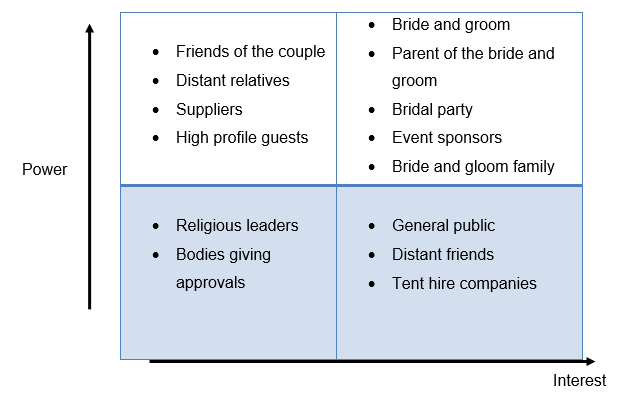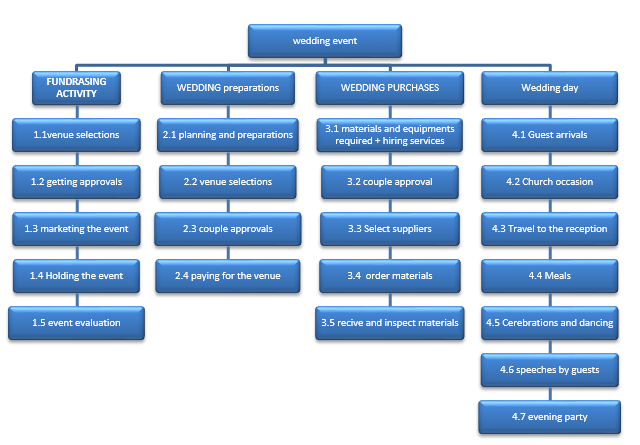Introduction
A project can be defined as a temporary endeavor that is undertaken by individuals, groups of people, or companies with the sole aim of creating a product, achieving a given result, or delivering a unique service. Project management, on the other hand, encompasses the use of knowledge, skills, tools, and techniques to achieve the intended goal (Burke, 2010). A project has five main parts, these include project commencement, planning, execution, monitoring and evaluations, and termination. All the processes and stages in a project must be carefully planned and synchronized to yield the desired results (Goldblatt, 2001).
Description of the project
This project details the project management plan for a wedding. The wedding will require adequate planning so that the event will be successful. The plans developed for this project can be applied to other weddings. Modern-day weddings are comprised of numerous activities that must be planned and executed well for the event to be successful (Maggie and Carrie, 2011). Wedding planning activities can be divided into three main groups, these are:
- Wedding planning activities
- Wedding event (activities that occur during the wedding)
- Post-wedding activities (events that occur after the wedding)
Aims and Objectives
The main aim of this work is to prepare a wedding event project management plan encompassing a detailed plan showing all the activities that will be carried out during the event, their schedule, and other pertinent information (Shone and Parry, 2004). The specific objectives of the project are:
- To carry out stakeholder analysis and determine the main stakeholders for this occasion;
- To develop a marketing plan for this event;
- To develop a budget for the wedding event;
- To develop a Gantt chart for the wedding event showing all the activities to be undertaken during the project implementation;
- To develop the evaluation methods that will be used to check the activities and ensure that they were carried out within the set deadlines and budget.
Feasibility study
A feasibility study can be defined as a prior investigation to determine the main features of the activity to be carried out. The feasibility study furnishes the project team with pertinent information about the nature of the project to be undertaken, the estimated time, and the resources required.
For this event, the main feasibility study involved checking from the internet, other academic sources, and previous events that have been carried out. During the feasibility, the following information was identified.
- A list of the main activities and steps that will be carried out during the wedding event;
- The main items required during the event;
- The main resources that will be required for this event;
- Any documentation and approvals that may be required;
- The types of risks and how they can be managed;
- Previous events of such nature and how they were managed;
- A survey of the marketing methods that have been used in such a previous event.
Stakeholder Analysis
Stakeholder analysis can be regarded as the process of identifying individuals, groups of people, and organizations that will be involved during the implementation of the project. Stakeholder analysis is imperative as the manager of the project has to identify the right people and organize them most feasibly to generate the required results. Stakeholder analysis is a three-tier process encompassing stakeholder identification, prioritizations, and formulating methods to deal with these stakeholders.
Stakeholder identifications
At this stage, the project team members and leader brainstormed to identify the key players in the wedding to be held. After the brainstorming process, the main stakeholders were identified as:
- The couple;
- The bridegroom family members;
- The bride family members;
- Bridal party;
- Friends of the bride and bridegroom;
- Distant relatives and other friends of the couple;
- The bodies are given approvals;
- Religious leaders of the church;
- Suppliers of the different items and products to be used during the event;
- Decorators;
- Tent hire companies;
- Car hire companies;
- Sponsors of the event;
- Celebrities and other high profile guests invited to the fundraiser as well as the wedding;
- General public (uninvited guests).
Stakeholder prioritization
After identifying the main stakeholders, the next step was to prioritize these stakeholders. The power interest grid is one of the common tools that are used in prioritizing the stakeholders. It classifies stakeholders based on power and interests and has four main quadrants as shown below.

Managing stakeholders
The different quadrants show the importance of all the stakeholders in the wedding plan. It can be noticed that the upper right quadrant represents the stakeholders with high power and high interest in the project, while the lower left quadrant represents those stakeholders with the lowest power and interest in the project. The main strategies of managing each of these stakeholders are given in the table 2 below.

Communication to stakeholders
In addition to the management of these stakeholders, the event manager must ensure that there is adequate communication to all the stakeholders. The stakeholder’s advice will also be taken into consideration during the planning and implementation of the event. The event manager will use the following:
- Sending invitations letters;
- Use of emails;
- Use of short message service (SMS) to all the relevant stakeholders;
- To ensure that they have received the messages, the stakeholders will be asked to SMS or email back acknowledging receipt of the communication;
- Holding meetings with the main stakeholders;
- Event advertisement to all stakeholders.
Risk management plan
Risk can be termed as the occurrence of an unpredicted or unlikely event during the implementation of the project. Risks are a part of project management and must be factored in during project management (Hopkin, 2012). Risk management entails the process of identifying and managing these risks. The wedding event can be said to be a highly complicated event susceptible to many risks. It is therefore imperative that the risks are identified and managed (Coleman, 2011). The process used to manage the risk is outlined below:
Risk identification
This was the first step and it entailed thorough brainstorming of all the project activities to identify a risk that can occur.
Categorizing the risks
The risks were then categorized based on their impact and the likely hood of them occurring. For example, risks that are likely to occur as well as those with high impact were given the priority as they have a direct effect on the project.
Identifying the mitigations methods
The methods of managing these risks were then outlined.
Risk evaluations and monitoring
The methods of evaluating the risk were then determined (Project Management Institute, 2008). This entails closely monitoring the event to identify new risks and formulate methods of controlling them.
Marketing Plan
The marketing plan encompasses all the methods that will be used to market and promote the event among all the key stakeholders during the event. The plan entails resource identifications, target market analysis, formulating the marketing objectives, developing the marketing strategies, identifying the tools and media to use, and evaluating the success of the process.
Situational analysis: The wedding event to be carried out must be advertised so those key stakeholders are aware of the event. The main strength is that the project team is well experienced in planning while the main weakness is the lack of enough funds to carry out the wedding. The threats are costly materials and activities to be undertaken that day. The main opportunities are the availability of funds from celebrities and sponsors. Also, if the event is successful, the event organizer will gain experience and get more clients.
Resources: The main resources required include funds, marketing people, and time.
Target market: These are the people that the marketing plan seeks to address, they include: the sponsors of the event, a distant relative of the couple, friends of the couple, and the other stakeholders. It is expected that most of these stakeholders are within the UK and so most of the activities will be local.
Marketing objectives. Marketing objectives must be SMART (specific, measurable, achievable, realistic, and timely). In line with this, our main marketing objectives are:
- To ensure that the fundraising event raises £10000 for the wedding event.
- To ensure that the final wedding event has at least 90% of all the guests
Marketing strategies: in this event, two main activities will be carried out, these are: the fundraising ceremony and the wedding event. The main marketing tools for the event are:
- Use of tickets: tickets will be printed out and given to the expected sponsors of the event. The sponsors will be asked to confirm if they will attend a fundraiser organized as a dinner party. The ticket will have an accompanying letter giving the details of the wedding event and the fundraising activity to be held. Because this is a private event, letters will be sent to the target audience.
- Wedding cards: Wedding cards will also be printed and distributed to the relevant stakeholders. For the email and social media users, e-cards will be designed and sent through the emails to all the friends, distant friends, relatives of the couple, and the sponsors to attend the wedding. Social media and emails have a great advantage in that the customer can give a response immediately.
Budget Plan
The budget for the event is shown in table 4 below. The budget has two main parts, the budget for organizing the fundraising activity and for holding the wedding event
Table 4: Project budget.
Project Plan and schedule (Gantt chart)
The project plan and schedule show the list of activities that will be performed during the whole project. The plan is derived from the Work Breakdown Structure (WBS) which shows the major activities that will be performed during the whole event (Lewis, 2002). The work breakdown structure shows all the events in an orderly manner and is shown below.

The Gantt chart for the wedding activities was prepared using the project management software (Maylor, 2001). It is shown in the appendices section.
Evaluation methods
It is imperative to monitor the event and ensure that it will be successful. This calls for monitoring of every activity to ensure that it will be carried within the necessary timelines and budget. Table 6 below shows the monitoring process for the whole project. Each activity is given and the method of monitoring it (Judy, 2009).
Conclusions
In culmination, this project detailed the preparation of a wedding event plan. The plan shows a detailed schedule of the different activities to be carried out, their timelines, and allocated budgets (Shone and Parry, 2004). The plan also includes the marketing strategies that will be used to ensure that the event is promoted among the key stakeholders.
Recommendations
It is expected that the wedding planner will follow the schedule developed here. It is important that the schedule is followed strictly and any changes should be adjusted noting the time and the cost implications they will have. It is also important that the outlined monitoring process be followed to ensure that the event is carried out within the budget and the schedule prepared.
References
Burke, R 2010, Fundamentals of Project Management 2nd edition, Burke Publishing, New York.
Coleman, T 2011, Practical Guide to Risk Management, Research Foundation of CFA Institute, London.
Goldblatt, J 2001, Special Events: The Art & Science of Modern Event Management, Wiley, Chichester.
Hopkin, P 2012, Fundamentals of Risk Management: Understanding, Evaluating and Implementing Effective Risk Management, Kogan Page, London.
Judy,A 2009, Event Planning: The Ultimate Guide To Successful Meetings, Corporate Events, Fundraising Galas, Conferences, Conventions, Incentives and Other Special Events, Wiley, New York.
Lewis, J 2002, Fundamentals of project Management, AMACOM, New York.
Maggie, D&Carrie, M 2011, Wedding Planning and Management, Routledge, London.
Maylor, H 2001, Project Management, Third Edition, Person publishers, Singapore.
Project Management Institute 2008, A Guide to the Project Management Body of Knowledge, Project management institute, New York.
Shone, A & Parry, B 2004, Successful Event Management A Practical Handbook. Thompson Learning, New York.
Appendices

Gantt chart showing all the activities for the project and their time schedules.